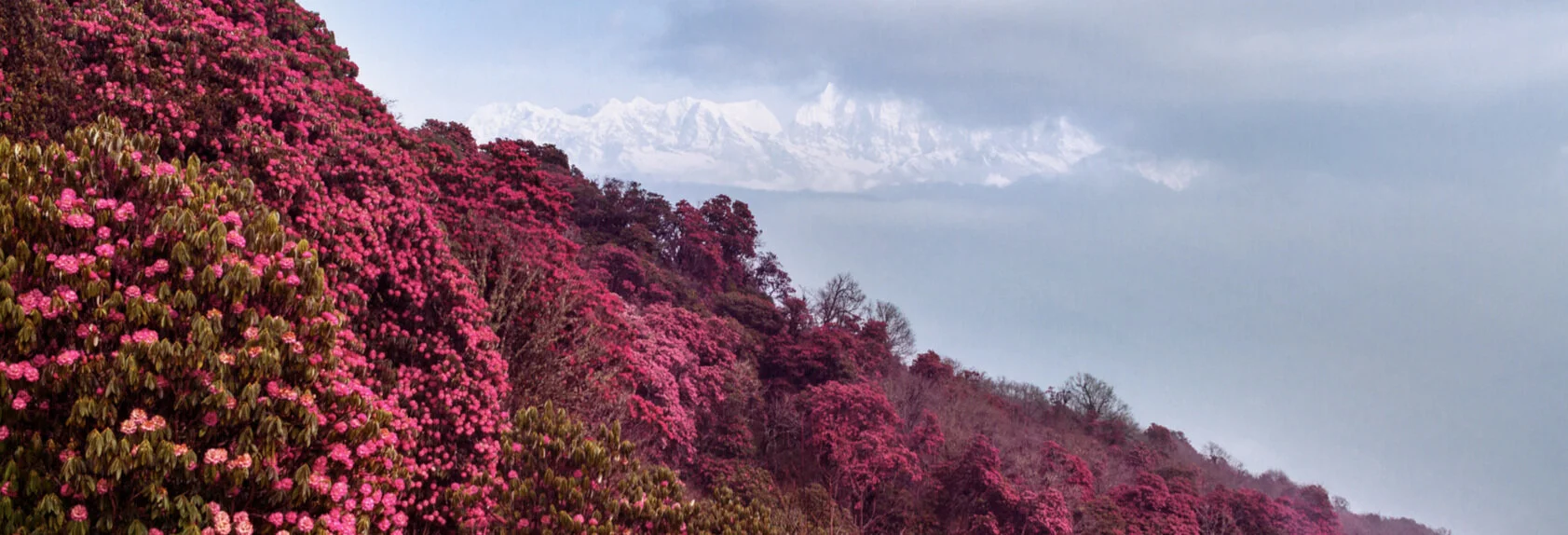These are the below projects our Christmas donations went to through Rainforest Trust and long-time partner, KTK-BELT who have been working to create a corridor of protection for wildlife across eastern Nepal. Their newest joint initiative is the creation of a 136,331-acre community protected area in the Tinjure-Milkhe-Jaljale (TMJ) Rhododendron Forest. This designation follows the successful purchase of 150 acres by Rainforest Trust and KTK-BELT last year, fortifying a core portion of the region and preventing road encroachment.
The TMJ is one of the most unique habitats in the country’s Himalayan region. Consisting of 33 high altitude lakes and 13 watersheds, the TMJ is a vital resource to local communities and lifeline for many iconic species. But currently, bulldozers for haphazard road construction and unsustainable development are scattered across the TMJ landscape, leaving the area’s forests, wetlands, and shrub lands vulnerable.

PROTECT GLOBALLY IMPORTANT PLANET SPECIES
Known as the ‘Rhododendron Capital of the Himalayas’, there are 28 species of rhododendrons and more than a thousand different plant species, of which more than 100 are endemic. Many plants and fungi used in traditional and modern medicine are also native to this area such as the Critically Endangered Spikenard and the Endangered Atis.
The TMJ falls within the Eastern Himalayas biodiversity hotspot and the Tamur valley and watershed Key Biodiversity Area, housing many endangered species including Critically Endangered Red-headed Vulture and White-rumped Vulture, as well as the Endangered Red Panda. In addition, the area is renowned for the presence of many wintering bird species such as Snow Partridge, Himalayan Monal, Rufous-winged Fulvetta, Rusty-cheeked Scimitar Babbler, Endangered Steppe Eagle and many others.

CREATING THE RED PANDA COMMUNITY FOREST
Since 2007, Red Panda Network has played a pivotal role in protecting forests in eastern Nepal by saving Red Panda habitat while simultaneously creating alternative income opportunities for rural communities. To advance this urgent conservation work, Rainforest Trust is joining forces with Red Panda Network to help designate and patrol a new 430,050-acre protected area for Red Pandas and a variety of other rare Himalayan species.
BIODIVERSITY
INTENSELY HUNTED FOR ITS UNIQUE RUSSET-AND-CREAM COLORED FUR AS WELL AS ITS HIGHLY VALUED BUSHY TAIL, THE ENDANGERED RED PANDA IS BECOMING INCREASINGLY RARE – PARTICULARLY AS ITS HABITAT QUICKLY DISAPPEARS, CAUSING A VERY REAL THREAT OF EXTINCTION.
The new 430,050-acre Red Panda Community Forest Reserve will be vital to ensuring a future for the species as it safeguards necessary habitat while connecting three other protected areas that secure an essential wildlife corridor. Other imperiled species will benefit from the new reserve as well, including the Critically Endangered Chinese Pangolin. A unique creature with a long snout, snaking tongue and sharp claws, the Chinese Pangolin can dig and lick up its favorite food: termites. This shy, nocturnal mammal is armor-plated with tough outer scales that enable it to curl itself into a tight ball when threatened. However, these defenses are useless against threats like habitat loss and poaching that are pushing the species ever closer to extinction. Today, despite its classification as critically endangered, the Chinese Pangolin is highly demanded on the black market for its scales that are used in traditional Chinese medicine, and the animal is openly sold as a food item in Chinese restaurants. Similarly, the largest mammal in the region, the Himalayan Brown Bear, was once found in large numbers but its population is rapidly declining as a result of habitat loss and poaching for its fur, claws and body parts that are also used for traditional medicine. Having lost most of its high-altitude habitat to logging, mining and agriculture, today the Himalayan Brown Bear is believed to occupy just two percent of its former range. Other fascinating mammals that call this region home and that will be protected by the new reserve include the Himalayan Wolf, Himalayan Blue Sheep, and Himalayan Tahr. Additionally, Snow Leopards are known from adjacent lands and may be found to exist in the area as well. Due to the presence of hundreds of Himalayan bird species, Birdlife International and Bird Conservation Nepal have designated the area as one of Nepal’s Important Bird Areas. Furthermore, the region harbors a number of threatened and endemic flora, including spruces, firs, larches and Himalayan yew, as well as numerous alpine plants.

So lovely Red Pandas…
CHALLENGES
LIKE MUCH OF THE EASTERN HIMALAYA, THE SITE OF THE PROPOSED COMMUNITY FOREST RESERVE IS UNDER IMMENSE PRESSURE DUE TO ITS UNPROTECTED STATUS.
While conservation measures are being carried out in some areas, the forest in the majority of the region is being degraded annually. Major threats include poaching as well as deforestation due to agriculture, cattle grazing, illegal logging, and collection of firewood.
COMMUNITIES
PEOPLE HAVE LIVED IN THE EASTERN HIMALAYAS FOR CENTURIES, AND SEVERAL GROUPS WITH VARIOUS CULTURES, LANGUAGES AND RELIGIONS LIVE IN AND AROUND THE AREA OF THE PROPOSED COMMUNITY FOREST RESERVE.
Hill tribes in the area include the Kirat, Gurung, Tamang, Bhotia, Magar, Sunwar and Sherpa. Other ethnic groups that have migrated into the area include Tibetans, Dalit, Chetri and Brahmins. The religious and cultural beliefs of these ethnic groups hold wildlife in high regard. Tribal women are the primary natural resource managers in this region of Nepal and will have an instrumental role in helping to organize and administer the new community forest reserve.

SOLUTIONS
TO PROTECT EASTERN NEPAL’S REMAINING FORESTS, RAINFOREST TRUST IS PARTNERING WITH RED PANDA NETWORK TO ESTABLISH THE RED PANDA COMMUNITY FOREST RESERVE WITH THE INVOLVEMENT OF LOCAL COMMUNITIES.
The proposed reserve will protect 430,050 acres of Himalayan forests and other essential habitat, strengthening protection for Red Pandas and a wealth of other rare Himalayan species. The new reserve will connect three other protected areas, including Nepal’s Kanchenjunga Conservation Area as well as India’s Singhalila National Park and Barsey Rhododendron Sanctuary. Collectively, these reserves will form an immense, contiguous protected area of Himalayan forests that will connect multiple elevation zones, providing a necessary refuge for a wide variety of wildlife. This community-based conservation area will be incorporated into the protected area system of the government of Nepal. A management plan will be developed, and conservation activities will be carried out by local people trained as forest guards who will actively patrol and monitor the new community forest reserve.
We couldn’t be prouder of the Rainforest Trust and their tireless work throughout the world to help re-balance the climate crisis. We look forward to supporting their projects for many years to come. Namaste. x








0 comments